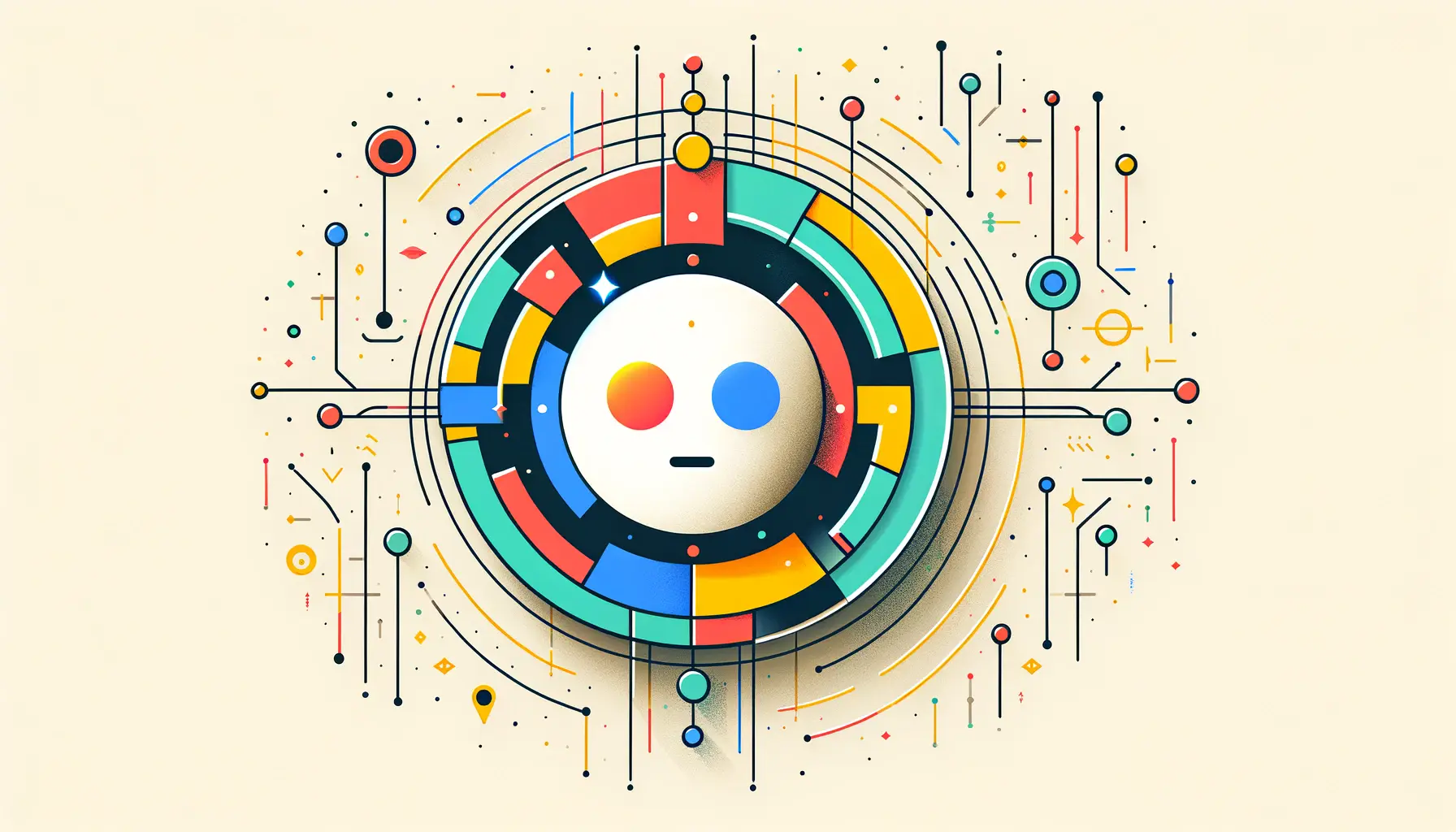In the rapidly evolving digital landscape, Google’s Bard emerges as a beacon of innovation, redefining the boundaries of artificial intelligence and user interaction.
This cutting-edge technology, developed by one of the most influential tech giants, aims to transform the way we interact with the digital world.
By leveraging the power of generative AI, Bard is not just a tool but a companion, designed to enhance the user experience through seamless communication and personalized responses.
The inception of Bard marks a significant milestone in Google’s quest to make information universally accessible and useful.
As we delve deeper into the capabilities of this AI-driven platform, it becomes evident that Bard is more than just an answer to its competitors.
It’s a testament to Google’s commitment to innovation, offering users a unique blend of convenience, efficiency, and personalization.
The essence of Bard lies in its ability to understand and interpret human language in a way that feels natural and intuitive, setting a new standard for user experience in the digital age.
- Understanding Google’s Bard: A Leap into the Future
- The Core Features of Google Bard
- Impact of Bard on User Experience and Engagement
- Challenges and Considerations in Implementing Bard
- Comparative Analysis: Bard vs. Other AI Chatbots
- Future Directions for Google Bard
- Maximizing the Potential of Google Bard in Various Industries
- Embracing the Future with Google Bard
- Google Bard FAQ
Understanding Google’s Bard: A Leap into the Future
The Genesis of Bard
Google’s Bard was born out of the necessity to bridge the gap between human curiosity and the vast expanse of knowledge available online.
In an era where information overload can often lead to confusion, Bard stands out as a guiding light, offering precise, contextually relevant information tailored to the user’s needs.
Its development is a testament to Google’s foresight in recognizing the potential of AI to revolutionize search and interaction paradigms.
The technology behind Bard is rooted in the latest advancements in AI and machine learning, particularly in natural language processing (NLP) and understanding (NLU).
These technologies enable Bard to comprehend queries in a human-like manner, providing responses that are not only accurate but also contextually enriched.
This level of understanding allows Bard to engage users in a conversational manner, making the search for information a more interactive and enjoyable experience.
Enhancing User Experience with AI
At the heart of Bard’s development is the goal of enhancing user experience.
Google has always been at the forefront of integrating AI into its services, and Bard is a significant leap forward in this direction.
By understanding the nuances of human language and the intent behind queries, Bard can offer personalized responses, making each interaction feel unique and understood.
This personal touch is what sets Bard apart, as it not only delivers information but also builds a connection with the user.
The implications of Bard’s capabilities are vast, extending beyond simple search queries to encompass a wide range of applications.
From helping users plan their day to offering creative inspiration and even assisting in learning new concepts, Bard is equipped to handle diverse user needs.
Its ability to provide succinct summaries, generate creative content, and offer explanations in simple terms makes it an invaluable tool for users across the spectrum.
This versatility underscores Google’s vision of creating a more informed, connected, and creative world.
Bard’s introduction signifies a pivotal moment in the integration of AI with daily digital interactions, promising a future where technology understands and responds to human needs more effectively than ever before.
The Core Features of Google Bard
Google Bard is not just another addition to the AI landscape; it represents a significant leap towards creating a more interactive and intuitive internet.
With its core features designed to enhance user experience, Bard integrates seamlessly into the daily digital routines of users worldwide.
Let’s explore the key features that make Google Bard a groundbreaking tool in enhancing user engagement and satisfaction.
Advanced Natural Language Processing
One of the standout features of Google Bard is its advanced natural language processing (NLP) capabilities.
This technology enables Bard to understand and interpret human language with remarkable accuracy.
The implications of this are profound, as it allows users to interact with Bard in a conversational manner, using natural language rather than structured queries.
This feature is pivotal in making information retrieval not only efficient but also more aligned with natural human communication patterns.
Personalized User Interactions
Bard takes personalization to the next level by tailoring responses to the individual user’s context and history.
This personal touch ensures that each interaction is relevant and meaningful, enhancing the overall user experience.
Personalization is achieved through:
- Contextual Understanding: Bard analyzes the user’s current query in the context of previous interactions, ensuring continuity and relevance in its responses.
- User Preferences: By learning from user interactions over time, Bard adapts its responses to align with the user’s preferences and interests.
Seamless Integration Across Google Services
Bard’s ability to integrate with a wide range of Google services further enhances its utility and convenience.
This integration allows users to access a variety of services through Bard, making it a central hub for information and tasks.
Key integrations include:
- Google Search: Bard leverages the power of Google Search to provide comprehensive answers to queries.
- Google Maps: Users can get location-based information and directions directly through Bard.
- Google Drive and Gmail: Bard can retrieve and summarize information from documents and emails, streamlining workflow and communication.
Real-time Information and Updates
Bard stands out for its ability to provide real-time information and updates, making it an invaluable tool for staying informed.
Whether it’s the latest news, weather updates, or live sports scores, Bard delivers timely information directly to the user.
This feature is particularly beneficial in our fast-paced world, where staying up-to-date is crucial.
The integration of advanced NLP, personalized interactions, seamless service integration, and real-time updates positions Google Bard as a transformative tool in the digital age, redefining how we interact with the web.
Impact of Bard on User Experience and Engagement
The introduction of Google Bard into the digital ecosystem marks a transformative shift in how users interact with technology.
Its sophisticated AI capabilities not only streamline the search process but also elevate the overall user experience.
This section delves into the tangible impacts of Bard on user engagement and satisfaction, highlighting the nuanced ways in which it reshapes our digital interactions.
The impact of Bard on user experience is multifaceted, encompassing improvements in efficiency, personalization, and accessibility.
By harnessing the power of AI, Bard offers a more intuitive and responsive interface, fundamentally changing the dynamics of user engagement.
The following points illustrate the significant ways Bard enhances the digital experience:
- Enhanced Efficiency: Bard significantly reduces the time and effort required to find information online. Its ability to understand and process natural language queries allows users to interact with the internet in a more direct and efficient manner.
- Increased Personalization: Bard’s AI algorithms tailor responses based on individual user preferences and past interactions. This level of personalization ensures that users receive information that is not only relevant but also aligned with their specific interests and needs.
- Improved Accessibility: Bard’s intuitive interface and conversational interaction model make the internet more accessible to users with varying levels of tech-savviness. By simplifying the search process, Bard opens up the wealth of online information to a broader audience.
Transforming Search into Conversation
Bard’s conversational approach to search represents a paradigm shift in how we access information.
Instead of navigating through lists of search results, users engage in a dialogue with Bard, making the process more interactive and engaging.
This conversational model not only makes searching more natural but also more enjoyable, fostering a deeper connection between users and technology.
Facilitating Learning and Creativity
Beyond its practical applications, Bard also serves as a catalyst for learning and creativity.
By providing explanations, summaries, and creative suggestions, Bard encourages users to explore new topics and express their ideas more freely.
This aspect of Bard has significant implications for education and creative pursuits, making it a valuable tool for students, professionals, and hobbyists alike.
The impact of Google Bard on user experience and engagement is profound, offering a glimpse into the future of human-AI interaction. By making digital interactions more efficient, personalized, and accessible, Bard not only enhances our online experience but also enriches our relationship with technology.
Challenges and Considerations in Implementing Bard
While Google Bard represents a significant advancement in AI-driven user experience, its implementation is not without challenges.
These hurdles stem from both technical complexities and ethical considerations, underscoring the need for careful planning and execution.
Addressing these challenges is crucial for maximizing Bard’s potential while ensuring it aligns with user expectations and societal norms.
The implementation of Bard involves navigating a series of technical and ethical considerations, each of which plays a critical role in its success.
From ensuring data privacy to maintaining accuracy and fairness, the following points highlight the primary challenges faced by Google in bringing Bard to the masses:
- Data Privacy and Security: As Bard processes vast amounts of personal and sensitive information, safeguarding user data is paramount. Implementing robust security measures and transparent data policies is essential to protect privacy and build trust among users.
- Accuracy and Reliability: Ensuring Bard’s responses are accurate and reliable is a significant challenge, given the dynamic nature of information. Continuous updates and improvements are necessary to maintain the integrity of the information provided.
- Addressing Bias: AI systems, including Bard, can inadvertently perpetuate biases present in their training data. Identifying and mitigating these biases is crucial to ensure Bard’s responses are fair and unbiased.
- Interoperability with Existing Systems: Integrating Bard seamlessly with existing Google services and third-party applications requires careful coordination and compatibility planning. This interoperability is key to providing a cohesive user experience.
Ensuring Ethical AI Use
Beyond technical challenges, ethical considerations play a pivotal role in Bard’s implementation.
Google must navigate issues related to transparency, accountability, and the potential impact of AI on employment and society.
Establishing ethical guidelines and engaging with stakeholders are vital steps in addressing these concerns.
User Adaptation and Education
Encouraging user adoption and educating the public about Bard’s capabilities and limitations are also critical.
As Bard introduces a new way of interacting with technology, guiding users through this transition is essential for its widespread acceptance and effective use.
Addressing the challenges and considerations in implementing Bard is essential for harnessing its full potential while ensuring it serves the best interests of users and society at large.
Comparative Analysis: Bard vs. Other AI Chatbots
The advent of Google Bard has sparked interest in how it stacks up against other AI chatbots in the market.
This comparative analysis delves into the unique features, strengths, and areas of improvement of Bard, juxtaposed with its contemporaries.
Understanding these distinctions is crucial for users and developers alike, as it highlights the evolving landscape of AI-driven communication tools.
When comparing Bard to other AI chatbots, several key factors come into play, including conversational abilities, integration capabilities, user experience, and the underlying technology.
The following comparison sheds light on how Bard distinguishes itself in the crowded AI chatbot space:
- Conversational Abilities: Bard’s foundation in Google’s advanced NLP and NLU technologies provides it with a nuanced understanding of human language, setting it apart from many competitors. Its ability to engage in more natural and contextually aware conversations offers a more human-like interaction experience.
- Integration with Google Ecosystem: Unlike standalone chatbots, Bard benefits from seamless integration with the broader Google ecosystem, including Search, Maps, and Gmail. This integration enhances Bard’s utility, making it a more versatile tool for users.
- User Experience: Bard’s focus on personalization and real-time information updates contributes to a superior user experience. Its ability to learn from user interactions and adapt its responses accordingly offers a tailored experience unmatched by many of its peers.
- Technology and Innovation: Bard is at the forefront of AI innovation, leveraging the latest advancements in machine learning and AI research. Its ongoing development reflects Google’s commitment to pushing the boundaries of what AI chatbots can achieve.
Areas for Improvement
Despite its strengths, Bard, like any technology, has areas for improvement.
Enhancing its understanding of complex queries, expanding language support, and further refining its bias mitigation strategies are ongoing challenges.
Addressing these areas will be crucial for Bard’s continued evolution and success.
Future Prospects
The future of Bard and AI chatbots, in general, is promising, with advancements in AI technology continually expanding their capabilities.
As Bard and its competitors evolve, we can expect to see even more sophisticated, intuitive, and helpful AI chatbots that further enhance our digital lives.
Bard’s integration with Google’s ecosystem, advanced conversational abilities, and focus on user experience set it apart from other AI chatbots, highlighting its potential to redefine digital communication.
Future Directions for Google Bard
The journey of Google Bard is far from over.
As it continues to evolve, the future directions for this innovative AI chatbot are both exciting and ambitious.
Google’s commitment to enhancing Bard with cutting-edge technology promises to unlock new possibilities for user interaction and information access.
Exploring these future directions not only gives us a glimpse into the potential of Bard but also into the broader trajectory of AI development.
Looking ahead, several key areas are poised to shape the future of Google Bard.
These developments are expected to further enhance its functionality, making it an even more integral part of our digital lives:
- Expansion of Language Support: Broadening the range of languages Bard supports is crucial for making it accessible to a global audience. Future updates are likely to include a wider array of languages, breaking down barriers and democratizing access to information.
- Deeper Integration with Google Services: Bard’s integration with Google’s ecosystem is set to deepen, offering users a more seamless experience across services. This could include more advanced functionalities within Google Docs, Sheets, and other productivity tools, making Bard a central hub for digital tasks.
- Enhanced Personalization Through AI Learning: As machine learning technologies advance, Bard’s ability to personalize interactions will become even more sophisticated. By better understanding individual user preferences and behaviors, Bard can offer more tailored and relevant information, enhancing the user experience.
- Improvements in Conversational Context and Memory: Future versions of Bard are expected to exhibit improved conversational memory, allowing for more coherent and contextually relevant interactions over longer periods. This will enable Bard to function more like a human conversational partner, remembering past discussions and preferences.
Addressing Ethical and Privacy Concerns
As Bard advances, addressing ethical and privacy concerns will remain a priority.
Ensuring transparency in how Bard processes and uses data, along with continuous efforts to mitigate biases in AI responses, will be crucial for maintaining user trust and ethical standards.
Collaboration with Developers and Users
Google is likely to foster closer collaboration with developers and users in the future development of Bard.
By opening up more opportunities for feedback and customization, Bard can better serve the diverse needs of its user base, driving innovation and inclusivity in AI chatbot technology.
The future of Google Bard is marked by continuous improvement and expansion, with a focus on inclusivity, personalization, and ethical AI use. As Bard evolves, it promises to redefine the boundaries of AI chatbots, offering users an unparalleled digital experience.
Maximizing the Potential of Google Bard in Various Industries
Google Bard’s capabilities extend far beyond personal use, offering transformative potential across various industries.
Its advanced AI and machine learning technologies can revolutionize how businesses interact with customers, streamline operations, and access information.
By leveraging Bard, industries can harness the power of AI to drive innovation, efficiency, and customer satisfaction.
The versatility of Google Bard makes it a valuable asset in numerous sectors.
Here are some ways different industries can maximize the potential of Bard:
- Customer Service: In the customer service sector, Bard can be integrated into chatbots to provide quick, accurate, and personalized responses to customer inquiries. This not only improves the customer experience but also reduces the workload on human customer service representatives.
- Education: Bard can serve as an educational tool, offering explanations, summaries, and learning resources in a conversational manner. This can enhance the learning experience for students of all ages, making education more accessible and engaging.
- Healthcare: In healthcare, Bard can assist with patient education, providing information on health conditions, treatments, and healthy living tips. It can also support healthcare professionals by offering quick access to medical research and information.
- Content Creation: For content creators and marketers, Bard can generate creative ideas, draft content, and provide insights on trending topics. This can streamline the content creation process and enhance creativity.
- Research and Development: Bard can accelerate the research process by quickly summarizing relevant studies, analyzing data, and offering insights. This is particularly valuable in fast-moving fields like technology and science.
Custom Solutions for Business Needs
Beyond these applications, businesses can develop custom solutions that integrate Bard into their operations, tailoring its capabilities to meet specific industry needs.
This could involve customizing Bard to interact with proprietary databases, perform specialized tasks, or integrate with industry-specific software.
Training and Development
As industries adopt Bard, investing in training and development will be crucial to maximize its potential.
Educating employees on how to effectively use Bard and develop AI-driven solutions will empower businesses to innovate and stay competitive in the digital age.
The misconception that AI like Bard will replace human jobs is being challenged by its potential to augment human capabilities, enhance productivity, and drive growth across industries.
Embracing the Future with Google Bard
The journey through the capabilities, impacts, challenges, and future prospects of Google Bard reveals a transformative tool poised to redefine our digital interactions.
As we stand on the brink of a new era in artificial intelligence, Bard emerges as a beacon of innovation, promising to enhance user experience across the globe.
Its development reflects Google’s commitment to pushing the boundaries of technology, making information more accessible, and interactions more intuitive and personalized.
The Path Forward
The evolution of Google Bard is a testament to the potential of AI to augment human capabilities and transform industries.
By addressing the challenges of data privacy, accuracy, and bias, Bard can achieve its full potential as a tool for positive change.
The future directions of Bard, including expansion of language support and deeper integration with Google services, highlight a roadmap towards a more inclusive and efficient digital future.
Maximizing Bard’s Impact
To fully harness the capabilities of Google Bard, industries and individuals alike must remain adaptable, embracing the opportunities it presents for growth and innovation.
The potential applications of Bard across customer service, education, healthcare, content creation, and research and development underscore its versatility and transformative power.
Custom solutions tailored to specific business needs can further unlock Bard’s potential, driving efficiency and competitiveness in the digital age.
- Investing in training and development to leverage Bard’s capabilities.
- Developing custom integrations to meet industry-specific needs.
- Continuously updating and refining Bard to address ethical and privacy concerns.
In conclusion, Google Bard represents a significant leap forward in the realm of AI chatbots, offering unprecedented opportunities to enhance user experience, streamline operations, and access information.
As we navigate the complexities of the digital landscape, Bard stands as a symbol of progress, embodying Google’s vision for a future where technology and humanity converge in harmony.
The journey with Bard is just beginning, and its impact on our digital lives is poised to be profound and far-reaching.
Google Bard FAQ
Explore the most frequently asked questions about Google Bard, offering insights into its capabilities, usage, and future directions.
Google Bard is an AI chatbot designed to enhance user experience by providing personalized, conversational interactions and access to a wealth of information.
Bard leverages advanced AI, including natural language processing, to understand and respond to user queries in a contextually relevant manner.
Bard can retrieve information, summarize content, brainstorm ideas, and generate creative outputs, making it a versatile tool for users.
Yes, Google Bard is a free experimental AI chatbot, accessible to users looking to enhance their digital interactions with AI-driven insights.
Users can access Bard through its dedicated platform, requiring a Google account for personalized interactions and full feature access.
Bard stands out for its deep integration with Google’s ecosystem, advanced conversational capabilities, and focus on providing a personalized user experience.
Currently, Bard primarily supports English, with plans to expand its language capabilities to cater to a global audience in future updates.
Future updates for Bard include expanding language support, enhancing personalization through AI learning, and improving conversational context and memory.












